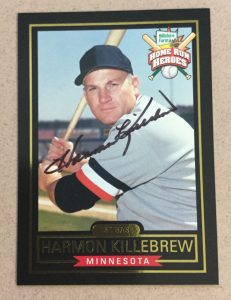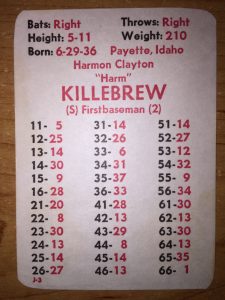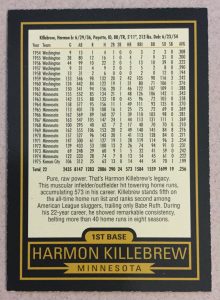The first time I heard the name, Harmon Killebrew, I was sitting in the center field bleachers at old Tiger Stadium in 1987. Recently, Mark McGwire had hit a ball over the left field roof at The Corner, and my brother, friend, and I were discussing the players who had hit home runs out of Tiger Stadium. We talked about Reggie Jackson’s blast in the 1971 All-Star Game that hit the light tower in right center field. We mentioned Kirk Gibson’s clout that cleared the roof in right and landed in the lumber yard across the street. Supposedly, it was “easier” to hit a home run over the right field roof…but left field…that was something much more challenging. For starters, it was 340 feet down the left field line at Tiger Stadium, compared to 325 feet down the right field line. In right field, there was an over hang of about ten feet, while in left field, the stands were set back from the lower level.  Over thirty times in its long history, home runs were hit over the right field roof of Tiger Stadium, but only four were ever hit over the left field roof. The first one was hit in 1962 by Harmon Killebrew. Then (1968) Frank Howard, (1987) Mark McGwire, and (1990) Cecil Fielder accomplished the feat. As I sat there in the center field bleachers, I couldn’t image someone hitting a ball so far. It was an amazing accomplishment.
Over thirty times in its long history, home runs were hit over the right field roof of Tiger Stadium, but only four were ever hit over the left field roof. The first one was hit in 1962 by Harmon Killebrew. Then (1968) Frank Howard, (1987) Mark McGwire, and (1990) Cecil Fielder accomplished the feat. As I sat there in the center field bleachers, I couldn’t image someone hitting a ball so far. It was an amazing accomplishment.
Harmon Killebrew is the epitome of a slugger, with his stocky and strong frame. Just a .256 lifetime hitter, Killebrew hit 573 home runs in his 22 seasons…but had only 2,086 hits. He lead the AL in homers six times. Eight times he hit 40 or more home runs. An average season for The Killer was a .256 average with 38 homers and 105 RBI…sounds like a Hall of Farmer. Killebrew spent 21 of his 22 seasons with the Washington Senators/Minnesota Twins organization. His final season was with the Kansas City Royals, primarily as a designated hitter. That is where he produced his final card in 1975.
| Split | G | GS | PA | AB | R | H | 2B | 3B | HR | RBI | SB | CS | BB | SO | BA | OBP | SLG | OPS | TB | GDP |
|---|---|---|---|---|---|---|---|---|---|---|---|---|---|---|---|---|---|---|---|---|
| 1975 Totals | 106 | 87 | 369 | 312 | 25 | 62 | 13 | 0 | 14 | 44 | 1 | 2 | 54 | 70 | .199 | .317 | .375 | .692 | 117 | 5 |
Even at the end of his career, Killebrew still could hit the long ball. His final card reflects that with a 66-1 and a 11-5. However, other than having five 14s, that’s about all Killebrew has going for him on this final card. You know the card is sub-par when it has 14s on 25, 31, and 51. His .199 average earned him only two 8s instead of the standard three. APBA did a great job with this card. It should produce a .200 average and the proper amount of home runs in 369 at bats. It’s one of the most accurate cards I’ve analyzed for Final Card Friday.
A few years ago, I was lucky to acquire a Harmon Killebrew autographed baseball card.  Killebrew had one of the nicest signatures of all the Hall of Famers on the autograph circuit. He took pride in his signature, unlike many current players. A while ago, I heard a story about Killebrew. He was at an autograph show with several other players and they were all signing the same item in an assembly line fashion. Killebrew was at the end of the line and noticed that some of the players were producing sloppy signatures. He made it a point to talk to those players and tell them how a big league ball player should sign an autograph. Like he did throughout his life, he made it a point to teach the younger players to take pride in the little things, even an autograph, because it ALL reflects on the person. That’s class. That was Harmon Killebrew.
Killebrew had one of the nicest signatures of all the Hall of Famers on the autograph circuit. He took pride in his signature, unlike many current players. A while ago, I heard a story about Killebrew. He was at an autograph show with several other players and they were all signing the same item in an assembly line fashion. Killebrew was at the end of the line and noticed that some of the players were producing sloppy signatures. He made it a point to talk to those players and tell them how a big league ball player should sign an autograph. Like he did throughout his life, he made it a point to teach the younger players to take pride in the little things, even an autograph, because it ALL reflects on the person. That’s class. That was Harmon Killebrew.
Special thanks to Jim Fraasch for suggesting Harmon Killebrew and supplying a picture of his final APBA card.
If you have a suggestion for Final Card Friday, please contact me. I’d be happy to add your suggestion to my list. Of course, a picture of the card would also be extremely helpful.






Nice report on the ‘Killer.’ IMHO I think 1969 was his best season.
Thanks. I think 1969 was probably his best season, but 1961 was probably his best APBA card.
Kevin, all things considered, the ’61 APBA Card probably is his best. It is also the card APBA chose for the original OFAS set. In my recently completed, 1961 Twins replay, Killer finished with the following: 677 PA (656 actual), .266 BA (.288 actual), 54 HR (46 actual), and 133 RBI (122 actual). Thanks for posting the ’75 Killebrew card!
I prefer the nickname “Killer”. Is this the only card if his career without a play result “24”?
I noticed no 24s too. I’m not sure if it’s his only card without any, but it certainly might be.
I saw Killebrew hit a monster home run at Fenway in 1964-one of the most prodigious blasts I have ever seen. It was a night game and the ball was a rising line drive that might still be going today if it had not hit the top row of the light bank in left-center field (nearly straight-away center). It was hit so hard that it knock out the power in the whole light bank!
Impressive. Obviously a memory that has stayed with you a long time.
Harmon Killebrew, somehow, became an A’s broadcaster in the late 70’s and 80’s. He came across as a guy who never, ever tooted his greatness, or called attention to his own Hall of Fame career. I can barely remember his playing days, but can totally remember his humility and lack of ego while he was a broadcaster. The guys working with him would really have to coax him to speak about his career. I loved listening to him, and frankly feel kind of conflicted that I’d consider Morneau, Hrbek and Gaetti instead of the “Killer” in BATS. He was also great friends with Wayne Walker, the Detroit Linebacker, who was a sportscaster for maybe 15 years or so in the Bay Area. I never met either of them, but really wish I was able to.